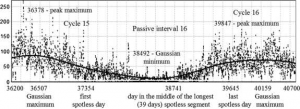Solar Physics
Volume 278, Number 2 (2012), 457-469,
Stanisław Zięba 1) and Zenon Nieckarz 2)
1) Astronomical Observatory, Jagiellonian University, Kraków, Poland
2) Institute of Physics, Jagiellonian University, Kraków, Poland
Download
http://www.springerlink.com/content/w9p8201458362192/
Abstract
Spotless days (i.e., days when no sunspots are observed on the Sun) occur during the interval between the declining phase of the old sunspot cycle and the rising phase of the new sunspot cycle, being greatest in number and of longest continuous length near a new cycle minimum. In this paper, we introduce the concept of the longest spotless segment (LSS) and examine its statistical relation to selected characteristic points in the sunspot time series (STS), such as the occurrences of first spotless day and sunspot maximum. The analysis has revealed statistically significant relations that appear to be of predictive value. For example, for Cycle 24 the last spotless day during its rising phase should be about August 2012 (± 9.1 months), the daily maximum sunspot number should be about 227 (± 50; occurring about January 2014±9.5 months), and the maximum Gaussian smoothed sunspot number should be about 87 (± 25; occurring about July 2014). Using the Gaussian-filtered values, slightly earlier dates of August 2011 and March 2013 are indicated for the last spotless day and sunspot maximum for Cycle 24, respectively.
